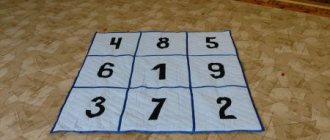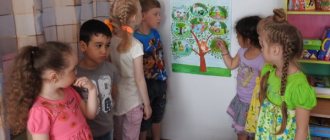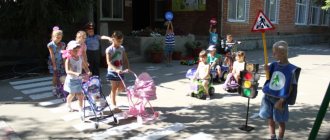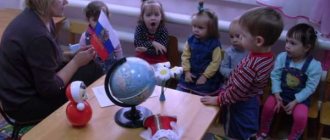Summary of the conversation with children of the middle group “Rules of safe behavior”
Galina Semyonova
Summary of the conversation with children of the middle group “Rules of safe behavior”
Conversation with middle group children
MDOU "Kindergarten "Friendship"
R. Dergachi village, Saratov region
«Rules for safe behavior in kindergarten»
Date: Monday, 09/02/2019 Educator: Semenova G. A. Topic : “ Rules of safe behavior in kindergarten ”
Goal: to educate children in the rules of behavior and communication in the kindergarten; develop the ability to obey safety rules , the desire to protect your health and the health of others.
Progress: 1. A Clown doll comes to the group .
Play out situations:
*while he is “running”
(not walking)
he hits the corner of the table;
*then trips over a thrown toy;
*wanted to get an object from the closet, climbed onto a chair and fell;
*almost climbed onto the window when he saw a dog (toy)
;
*when they finally put him on a chair, he sits and rocks.
with the children (the teacher explains to the children that the Clown is soft, and if this happened to the children , they would have to call an ambulance doctor by phone -03, explain to Bob what he did wrong , why he behaved this way you can’t, but how to behave correctly (state the RULES )
and show the plot picture.
2. Examination of a plot picture, where all the children are busy with their own business, no one makes noise, runs, pushes, there is order in , etc. d. Conversation on it . Also tell (discuss)
children about
the rules of behavior in the bedroom and reception room.
Bring children to the idea that they MUST obey safety rules , because this is necessary to preserve the life and health of themselves and other people!
*Scattered toys can cause falls and injury.
Order in the group is not only for cleanliness, but also for safety !
*You cannot climb onto the windowsill, table or cabinets.
If you can’t get it, ask a teacher!
*It is very dangerous to run around the group , bedroom and reception area: sharp corners of furniture can cause injury; colliding with another child can cause severe bruising!
*Do not put small toys in your mouth - you may accidentally swallow them and choke!
*You can't rock on a chair! If you lose your balance, you will fall and hit yourself!
*When playing with water, make sure that water does not get on the floor.
A wet floor is very slippery and therefore dangerous for you!
*Do not talk while eating, chew your food thoroughly!
*Shoes should always be fastened and comfortable, without long laces!
*It is prohibited to bring chewing gum to the clinic to avoid accidents!
- Where do we go in the kindergarten? What kind of premises are there in the nursery? (Music room, gym, medical room, etc.)
— How should we behave when we move around the village?
The teacher shows the children a map of the kindergarten premises and explains where everything is located.
Repetition of the rules together with Dunno (can be voiced in a tape recording)
:
-When going down the stairs, you need to walk one after another, at a calm pace, without pushing, holding on to the railing;
-You must move along the corridors of the school calmly, keeping right hand to the side of the corridor;
-Carefully cross the intersections of corridors, because you cannot see who may be coming towards you;
-When moving along the corridors, always look ahead so as not to bump into ledges in the walls or nannies rushing to the kitchen and back with pots;
-Corridors and stairs are not a place for games and pampering. Remember this!
-Do not open the doors with your foot, and also do not open them sharply, because there may be a person on the other side of the door, and you will hurt him! (Oh guys, -
Believe it or not, -
The door ran away from me.
“Goodbye,” she said, “darling,”
You opened me with your foot)
Card index of conversations on moral education (middle group). card index (middle group) on the topic
Card index of conversations
on moral education
in children in the middle group
card-1
Why do they say "hello"?
Goal: To form in children the basic rules of etiquette when meeting. To introduce them to ways of greeting. To consolidate ideas about the importance and necessity of using “kind words” in colloquial speech, to arouse the desire to use them.
card-2
"My good deeds"
Goal: to deepen children’s understanding of kindness as a valuable, integral quality of a person. Improve communication skills (the ability to listen to a friend, sincerely express one’s opinion, show kindness to the opinions of other children), skills of cultural communication with peers. Achieve friendly intonation expressiveness of speech. To cultivate in children friendly relationships, feelings of self-esteem and respect for others, the ability and desire to come to the aid of adults and peers.
card-3
"What is kindness"
Goal: To form children’s idea of kindness as an important human quality. Encourage the desire to do good deeds; strengthen children’s ideas about good deeds, understand that polite words help people communicate. Form moral ideas about kindness. Cultivate kind feelings towards people around you.
card-4
"Hurry to do good"
Goal: Continue familiarization with the polar concepts of “good” and “evil.” Form a conscious attitude towards social norms of behavior, consolidate the skills of friendly behavior in everyday life. Introduce ways to resolve conflict associated with feelings of anger, as well as ways to manage and regulate mood. Continue to cultivate friendly relationships between children.
card-5
“If you are kind...”
Goal: To develop in children the need for friendly communication with others, to consciously show empathy and perform kind deeds. To teach to understand the meaning of proverbs about goodness, the ability to associate the meaning of a proverb with a specific situation. Teach children to show kindness and responsiveness to everyone who needs it.
card-6
"Polite words"
Goal: To teach children the rules of etiquette, forms and techniques of communication when meeting with acquaintances and strangers, the rules of using greetings. Help overcome shyness and stiffness in children. Develop the ability to express your opinion in a cultural way, listen carefully to your interlocutors. Teach formulas for expressing polite requests and gratitude.
card-7
"Accidentally and on purpose"
Goal: to develop moral feelings - regret, sympathy; develop gaming communication skills without hurting your partner’s interests.
card-8
"Learning to forgive your friends"
Goal: to develop children’s ability not to be offended by each other; develop the ability to distinguish between an accidental mistake and an intentional one and react accordingly; lead children to understand the words “peace-loving”, “touchy”.
card-9
"Why do there be fights? "
Goal: to develop communication skills in children; develop an understanding of the meaning of norms and rules of behavior among peers; cultivate the habit of behaving with dignity in every situation.
card-10
"Dreamers and liars"
Goal: to develop the ability to distinguish between deception and fiction, fantasy; develop a desire for truthfulness and tact.
card-11
" Let's make it up "
Goal: develop the ability to restrain negative impulses, avoid conflicts, find words to evaluate behavior. Teach children responsiveness and sensitivity.
card-12
"A good friend is a friend in need"
Goal: to form the idea that a true friend knows how to empathize and help in difficult times; develop the ability to be merciful to each other.
card-13
"How to behave during a conversation"
Goal: to introduce children to the rules of behavior during a conversation.
(Speak in a polite tone. Use “magic” words. Look at the interlocutor’s face. Do not keep your hands in your pockets. You should not eat during a conversation. If two adults are talking, the child should not interfere in their conversation, much less demand that it stop) .
card-14
"Kind angry"
Goal: To teach to give a moral assessment to the actions of heroes, to cultivate a desire to be kind and humane. To help you understand that a kind person can be called a person who always helps others and does not remain indifferent in situations that are difficult for other people.
Teach to distinguish good deeds, create a desire to do good deeds towards people around you.
card-15
"Truthfulness"
Goal: To form ideas about the moral concept of “truthfulness”, to teach how to give a moral assessment of the hero’s actions, to help understand that a lie does not decorate a person.
card-16
"What a friend should be"
Goal: To form ideas about positive character traits and moral actions, to deepen ideas about friendship. To cultivate respect, patience and friendliness towards one’s comrades, to teach them to correct their mistakes, to ask for forgiveness in conflict situations. To teach children responsiveness and sensitivity.
card-17
"Be neat and orderly"
Goal: To teach children to take care of their appearance. Help you understand that a well-mannered person always looks neat.
card-18
"Truth is not true"
Goal: To explain to children that they should not deceive others, that they should always tell the truth, that truthfulness and honesty always please adults, that these qualities are highly valued in a person, that they are praised for telling the truth. To help children understand that any lie is always revealed, and a person who lies feels guilty not only for his offense, but also for the fact that he told a lie.
card-19
"Goodwill"
Goal: to continue to instill in children a negative attitude towards rudeness. Explain to children that the one who teases not only offends others, but also causes harm to himself (no one wants to be friends with such a person).
card-20
"Games without quarrels"
Goal: Explain to children that a quarrel interferes with play and friendship. Teach how to resolve controversial issues, avoid quarrels, do not get angry at losing, do not tease the loser..
card-21
"Politeness"
Goal: To teach children to use polite words, develop appropriate skills of cultural behavior, observe the rules of etiquette, using the example of images of literary heroes, stimulate positive forms of behavior and inhibit negative ones. That you need to communicate with others calmly, without shouting, that you should express your requests in a polite tone.
card-22
"Thrift"
Goal: To teach children to treat things with care and precision, otherwise they will quickly lose their appearance and become unusable. Teach to appreciate the work of those who made this thing, who bought it, earning money.
card-23
"Mutual Aid"
Goal: Explain to children that all people sometimes need support, but not everyone can ask for help; It is very important to notice the person who needs help and help him. That you need to help not only acquaintances, but also strangers.
card-24
"Striving to Help"
Goal: To develop emotional responsiveness, the desire to provide help, showing sympathy. To teach children responsiveness and sensitivity.
card-25
"Generosity and Greed"
Goal: To reveal the meaning of the concepts of “greed” and “generosity”. Develop the ability to evaluate your attitude towards positive and negative actions. Understand that being greedy is bad, but generous is good.
card-26
“Why you need to be able to give in”
Goal: to teach children to avoid quarrels, give in and negotiate with each other. Develop the ability to evaluate your attitude towards positive and negative actions.
card-27
"Steps of Kindness"
Goal: based on the content of Russian folk tales, to form in children an idea of justice, courage, modesty and kindness, to cultivate a negative attitude towards negative qualities: lies, cunning, cowardice, cruelty. Learn to convey your attitude to the content of the fairy tale and the actions of the characters.
card-28
"It's better to be kind"
Purpose: To give children an idea of an indifferent, indifferent person and his actions. Teach children to distinguish between the external manifestations of an emotional state (anger, indifference, joy). Learn to analyze actions, find the cause of the conflict, ways to resolve conflict situations and promote their assimilation in behavior. Generalize the idea of kindness and evoke the desire to do good deeds.
nsportal.ru/detskii-sad/…




